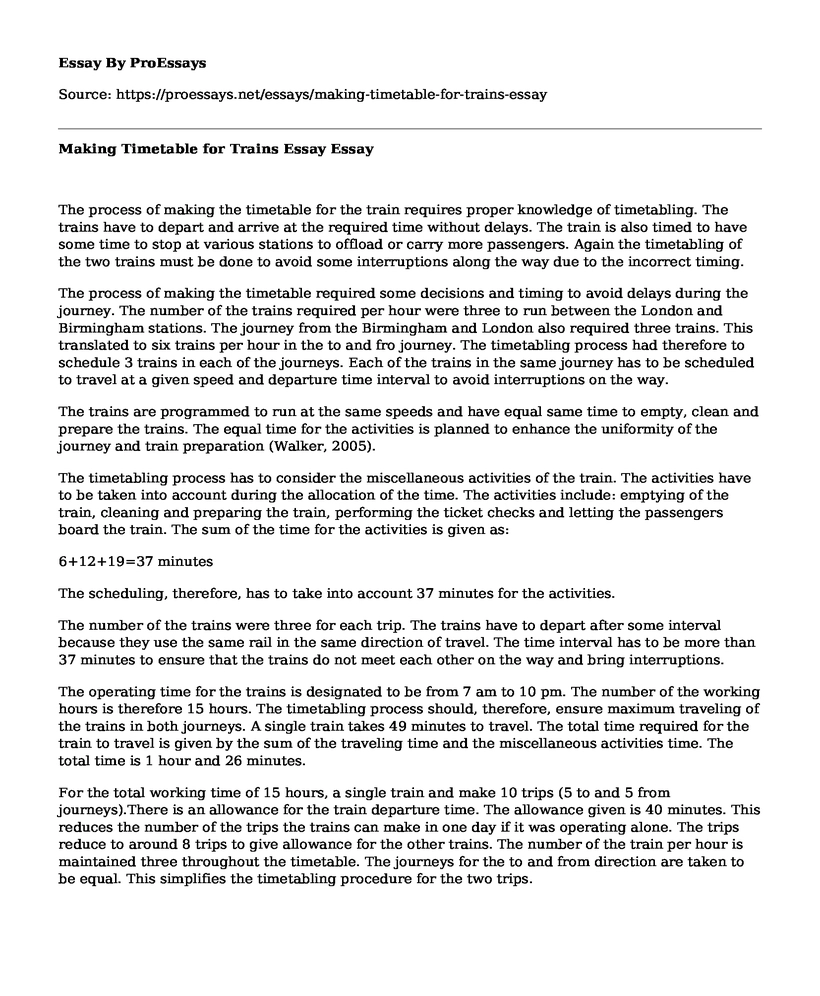The process of making the timetable for the train requires proper knowledge of timetabling. The trains have to depart and arrive at the required time without delays. The train is also timed to have some time to stop at various stations to offload or carry more passengers. Again the timetabling of the two trains must be done to avoid some interruptions along the way due to the incorrect timing.
The process of making the timetable required some decisions and timing to avoid delays during the journey. The number of the trains required per hour were three to run between the London and Birmingham stations. The journey from the Birmingham and London also required three trains. This translated to six trains per hour in the to and fro journey. The timetabling process had therefore to schedule 3 trains in each of the journeys. Each of the trains in the same journey has to be scheduled to travel at a given speed and departure time interval to avoid interruptions on the way.
The trains are programmed to run at the same speeds and have equal same time to empty, clean and prepare the trains. The equal time for the activities is planned to enhance the uniformity of the journey and train preparation (Walker, 2005).
The timetabling process has to consider the miscellaneous activities of the train. The activities have to be taken into account during the allocation of the time. The activities include: emptying of the train, cleaning and preparing the train, performing the ticket checks and letting the passengers board the train. The sum of the time for the activities is given as:
6+12+19=37 minutes
The scheduling, therefore, has to take into account 37 minutes for the activities.
The number of the trains were three for each trip. The trains have to depart after some interval because they use the same rail in the same direction of travel. The time interval has to be more than 37 minutes to ensure that the trains do not meet each other on the way and bring interruptions.
The operating time for the trains is designated to be from 7 am to 10 pm. The number of the working hours is therefore 15 hours. The timetabling process should, therefore, ensure maximum traveling of the trains in both journeys. A single train takes 49 minutes to travel. The total time required for the train to travel is given by the sum of the traveling time and the miscellaneous activities time. The total time is 1 hour and 26 minutes.
For the total working time of 15 hours, a single train and make 10 trips (5 to and 5 from journeys).There is an allowance for the train departure time. The allowance given is 40 minutes. This reduces the number of the trips the trains can make in one day if it was operating alone. The trips reduce to around 8 trips to give allowance for the other trains. The number of the train per hour is maintained three throughout the timetable. The journeys for the to and from direction are taken to be equal. This simplifies the timetabling procedure for the two trips.
References
Walker, C.G., Snowdon, J.N. and Ryan, D.M., 2005. Simultaneous disruption recovery of a train timetable and crew roster in real time. Computers & Operations Research, 32(8), pp.2077-2094.
Cite this page
Making Timetable for Trains Essay. (2022, Mar 29). Retrieved from https://proessays.net/essays/making-timetable-for-trains-essay
If you are the original author of this essay and no longer wish to have it published on the ProEssays website, please click below to request its removal:
- Logistics as a Function of the Supply Chain Essay
- The Food Truck Business Questions and Answers Paper Example
- Public Transportation Paper Example
- Freight Brokerage Essay Example
- Paper Example on Non-Emergency Transportation: Ensuring Access to Healthcare for Everyone
- The Room Book Trajectory
- Innovation, Collaboration, and Global Delivery Strategies - Free Paper Sample







